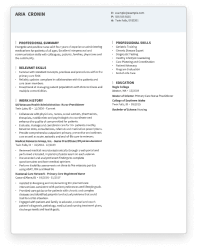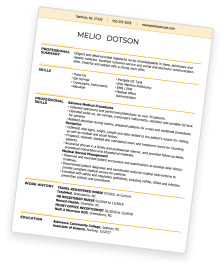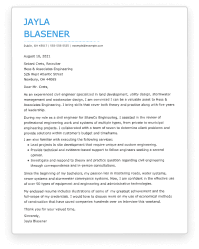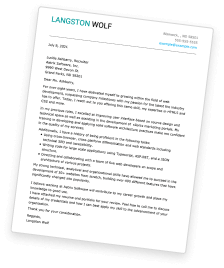Daycare Assistant Resumes: Overview
Being a daycare assistant is all about nurturing young minds and providing a safe, engaging environment for children. Your role is pivotal in assisting with the development and care of children in their early years, making every day a rewarding experience.
Other job titles a daycare assistant may go by include:
- Daycare Aide
- Childcare Worker
- Preschool Assistant
- Nursery Assistant
- Early Childhood Assistant
- Infant Caregiver
To excel as a daycare assistant, having patience, empathy, and a strong understanding of early childhood development are key.
Additionally, skills in communication, first aid, and creative play are highly valued. These qualifications ensure that you provide the best care and educational support to young children.
Looking to craft a standout daycare assistant resume? Hloom is here to help. Our website boasts an array of resume examples tailored for childcare professionals.
Whether you’re just starting out or looking to advance your career, explore our resume builder, check out our examples page, and dive into our templates to create a resume that highlights your unique strengths. Let’s take the next step together in nurturing your career!
Daycare Assistant Resume: Getting Started
Kicking off your daycare assistant resume might seem daunting, but selecting the right format is your first step to success.
Your resume’s format should highlight your strengths, showcase your experience, and make a memorable impression on potential employers. Let’s explore which format suits you best.
Chronological Resumes for Daycare Assistant
The chronological resume format is highly recommended for daycare assistants, especially those with a solid track record in childcare.
This layout emphasizes your work history, listing your jobs in reverse chronological order, starting with the most recent. It’s perfect for showcasing your growth and experience in early childhood education environments.
This format is the most preferred by employers and helps highlight your commitment and progression in childcare.
Due to this, the chronological resume format is the most friendly for applicant tracking systems (ATS).
Functional Resumes for Daycare Assistant
For individuals new to childcare or those with gaps in their employment history, a functional resume may be the way to go.
This format focuses on your skills and qualifications rather than your job history. It’s ideal for career changers or recent graduates, emphasizing your capabilities in childcare, such as communication, patience, and creativity, without tying them to specific job roles.
This can help you demonstrate your potential as a nurturing and effective daycare assistant.
Combination Resumes for Daycare Assistant
A combination resume blends the best of both chronological and functional formats. It allows you to highlight your most relevant skills and qualifications at the top, followed by a detailed work history.
This format is particularly useful for those with a diverse set of experiences or those looking to make a lateral move within childcare. It showcases your versatility and adaptability, key traits for a successful daycare assistant.
Choosing a Resume Format
Choosing the right resume format is crucial for your job search as a daycare assistant.
While the chronological resume is generally preferred for its straightforward presentation of your work history, don’t shy away from the functional or combination formats if they better suit your situation.
Consider your experience, career goals, and the message you want to send to potential employers. Whichever format you choose, ensure it reflects your strengths and positions you as the ideal candidate for the job.
How to Write a Daycare Assistant Resume
Selecting a layout for your daycare assistant resume is the first step in the creation process. There are five essential sections you must include to provide a comprehensive overview of your qualifications.
The five crucial sections for a resume are:
- Contact Information
- Summary or Objective
- Work Experience
- Skills
- Education
You can also provide additional sections, such as certifications and volunteer experience, to help expand your relevant qualifications.
Each of these sections is instrumental in showcasing your qualifications for a daycare assistant role, ensuring you’re well-prepared for success in the field!
Contact Details
Include your complete name, telephone number, a professional email address, and your location (including both the city or town and state) in your contact details.
If relevant, you can also add your LinkedIn profile or any online portfolio or website that showcases your expertise in childcare.
Position your contact details prominently at the top of your resume, ensuring they are easily visible and legible.
Aim for a design that makes your name stand out, but be careful not to let the styling of this section detract from the content that follows.
Here is an example of how it might appear:
Jane Doe
Phone: (555) 123-4567
jane.doe@fake.email.com
fake.linkedin.com/in/janedoechildcare
Summary or Objective
Directly below your contact details, your resume should feature a section that introduces you to prospective employers.
You can opt for either a resume summary or an objective statement based on your background and career aspirations.
A resume summary provides a concise overview of your key skills, experiences, and professional objectives, making it an ideal choice for those with relevant work history.
For a daycare assistant, an effective summary might be:
“Experienced Daycare Assistant with over ten years of hands-on experience in early childhood education settings. Renowned for implementing innovative educational techniques that enhance children’s learning and social skills. Demonstrated success in fostering a safe and stimulating environment for young learners, with a commitment to nurturing their developmental milestones.”
An objective statement, on the other hand, is suited for individuals who may be new to the field but are passionate and eager to make a positive impact. It focuses on your career goals and enthusiasm for the role.
An engaging objective for a daycare assistant could be:
“Enthusiastic and caring Daycare Assistant with a strong understanding of children’s educational and emotional needs. Skilled in creating engaging activities and a supportive learning environment for children of all ages. Adept at classroom management and with preliminary experience in childcare settings. Motivated to further develop my skills in early childhood education and contribute to the enrichment of the daycare’s program.”
Remember, whichever option you choose, it’s a chance to highlight the skills and experiences most relevant to a daycare assistant role, using keywords from the job description to ensure your resume resonates with both applicant tracking systems (ATS) and hiring managers.
Work History
For your daycare assistant resume, presenting a detailed work history section is key to highlighting your relevant background and skills.
Employers seek concrete examples of your work history and accomplishments as proof of your capabilities in this role.
Begin with your latest job and proceed in reverse chronological order, focusing on positions most relevant to a daycare assistant role.
This strategy emphasizes your applicable experience, encouraging employers to see you as a strong candidate. Be sure to showcase duties and achievements that reflect your suitability for the daycare environment.
Use dynamic verbs to depict progress and responsibility, and whenever possible, quantify your successes with figures or percentages.
Metrics lend weight to your claims, offering a tangible measure of your contributions and setting you apart by illustrating the unique value you bring to the table.
Below is an example of how to structure the experience section of a daycare assistant resume:
Daycare Assistant
Little Explorers Daycare, Hometown, USA
01/2019 – Present
- Implemented creative play and learning activities, leading to a notable 10% improvement in child engagement.
- Spearheaded a language development program, increasing children’s vocabulary by an average of 15%.
- Enhanced parental engagement by initiating quarterly parent-teacher meetings, which saw a participation increase of 30%.
- Integrated digital tools into daily activities, enriching children’s tech skills by 25%.
- Worked collaboratively with the daycare team to develop and refine a holistic early childhood education curriculum.
Skills
In your resume, prominently feature a skills section that outlines your most pertinent hard skills and soft skills for a daycare assistant role.
Concentrate on those skills that are directly applicable to the position you’re aiming for, demonstrating a well-rounded capability set.
Crucial hard and soft skills for daycare assistants may include:
Top 5 Hard Skills for Daycare Assistant Resumes
- Child Development Knowledge: Understanding the physical, cognitive, and social development stages of children is essential for crafting appropriate activities and interactions.
- Safety and First Aid: Competence in child safety and first aid is vital for ensuring the wellbeing of children under your care.
- Activity Planning: Ability to design and implement engaging, educational activities that support learning and development goals.
- Behavior Management: Skills in managing a range of behaviors in a positive and effective manner to maintain a harmonious environment.
- Educational Software Proficiency: Familiarity with child-friendly educational software and tools can enhance learning experiences and engagement.
Top 5 Soft Skills for Daycare Assistant Resumes
- Patience: Working with young children requires a high level of patience, particularly in managing behaviors and fostering a positive learning environment.
- Adaptability: The ability to adjust quickly to changing situations and needs within the daycare setting is crucial.
- Communication: Strong verbal and written communication skills are essential for interacting with children, parents, and colleagues.
- Organizational Skills: Keeping activities, schedules, and child records organized is key to a smoothly running daycare.
- Creativity: Employing creativity to make daily activities and learning experiences fun and engaging sets exceptional daycare assistants apart.
An example of how the skills section might be formatted on a daycare assistant resume:
Skills
- Child Development and Psychology
- Emergency Response and First Aid
- Engaging Activity and Lesson Planning
- Effective Behavior Management Techniques
- Advanced Communication and Interpersonal Abilities
Education
In your daycare assistant resume, the education section should detail your most advanced degree, including the institution’s name and location.
Optionally, you can mention your graduation date, pertinent coursework, and any awards or certifications you’ve earned.
Depending on its relevance to the daycare assistant role and how you want to structure your resume, you may choose to include this information within a unified section or separate them as needed.
Prioritize the content based on its importance to the job and the space available on your resume.
Here’s how the education section might be presented for a daycare assistant:
State University
City, State
Bachelor of Science in Early Childhood Education
Include any specific educational prerequisites, especially if the daycare center or state regulations require them.
Although requirements can vary between institutions, presenting your qualifications clearly and concisely is crucial. Always tailor this section to meet the job’s needs, closely reviewing the job listing to ensure you highlight the necessary educational background.
Additional Sections
If relevant and concise, additional information on your daycare assistant resume can enhance your candidacy without overcrowding the document.
For a daycare assistant, consider adding sections such as:
- Certifications
- Volunteer Work
- Professional Memberships
- Awards and Recognitions
- Pertinent Interests
These sections can be integrated with the main parts of your resume or listed separately to highlight your qualifications more distinctly.
Top Certifications for Daycare Assistants
Certifications are crucial for daycare assistant resumes, emphasizing your professionalism and specialized skills.
They affirm your capability and dedication to fostering a nurturing learning environment for children.
Popular certifications for daycare assistants might include:
- Child Development Associate (CDA): This certification is foundational for individuals in early childhood education, underscoring your expertise in nurturing the emotional, physical, and intellectual development of young children.
- First Aid and CPR Certification: Essential for ensuring the safety and well-being of children, showing that you are prepared to act in emergency situations.
- Special Needs Care Certification: This certification is invaluable for those who wish to specialize in caring for children with diverse needs, demonstrating a commitment to inclusive education.
- Early Childhood Education (ECE) Certification: Validates your specialized knowledge and skills in teaching and caring for young children.
- Classroom Management Certification: Although more commonly associated with formal education settings, this certification can also benefit daycare assistants by enhancing their ability to create a structured and positive environment.
8 Tips for Daycare Assistant Resumes
Customize Your Resume: Adjust your resume for each application, making sure it matches the specific needs and requirements of the daycare. Incorporate aspects from the job description to demonstrate your alignment with their values and needs.
Use Dynamic Verbs: Describe your responsibilities and achievements with compelling action verbs. Words like facilitated, implemented, nurtured, or developed can make your resume more engaging and impactful.
Quantify Your Impact: Highlight measurable outcomes from your work, such as improvements in children’s social skills or enhancements in daily operations. Use numbers and percentages to provide evidence of your contributions.
Incorporate Keywords: Leverage relevant keywords from the daycare assistant job description to ensure your resume passes through any applicant tracking systems (ATS) and clearly conveys your qualifications.
Showcase Behavior Management: Emphasize your ability to maintain a supportive and structured environment. Include examples from your experience to illustrate your effective management of challenging behaviors or situations.
Parental Communication: Detail your experience with successful parent communication, showcasing your capability to foster strong, trust-based relationships and keep parents informed about their children’s progress and well-being.
Technology Proficiency: Highlight your skills in integrating technology into activities or educational content, and mention any specific software or tools you’re familiar with that enhance learning or administrative efficiency.
Proofread for Perfection: Ensure your resume is impeccable, with no spelling or grammatical errors. A well-polished resume reflects your professionalism and attention to detail, crucial qualities for any daycare assistant.
Helping Job Seekers Like You


Use Hloom's Resume Builder
Key Takeaways
- Customize your resume for each daycare assistant role by highlighting relevant skills, experiences, and qualifications that align with the specific job description.
- Focus on both hard and soft skills crucial for a daycare assistant, such as knowledge of child development, safety and first aid, activity planning, patience, adaptability, and communication.
- Use dynamic verbs and quantify your accomplishments to demonstrate your impact in previous positions, showing how you’ve contributed to children’s learning and well-being.
- Include your educational background, particularly in early childhood education, and any relevant certifications such as Child Development Associate (CDA) or First Aid and CPR. These qualifications underscore your expertise and commitment to providing high-quality childcare.
- If space allows, add sections for certifications, volunteer work, professional memberships, or awards that further demonstrate your qualifications and dedication to childcare.
Use Hloom's Cover Letter Builder













